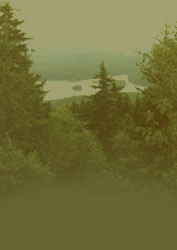|
Do you have something
happening in your corner of Washington? - Please call a member
or e-mail your observations to have them included here
November:
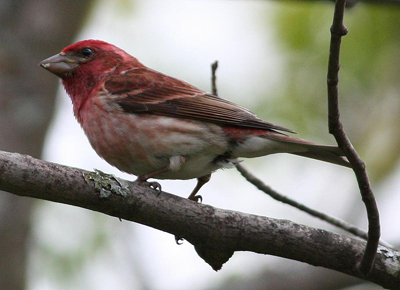
Purple Finch picture from Wikicommons
We have been talking about song birds and
wondered about how the changing habitat and climate is effecting
them.
Climate change is a large event that has
been widely discussed and most people know the consequences
of it - rising sea levels, more frequent and severe weather
events, drought, extinctions, the spread of disease. But most
people don't think about the smaller changes that warming
brings and their effects on our local plants and wildlife.
New Hampshire is home to an incredible
diversity of native wildlife species, including 283 birds,
64 mammals, 50 fish, 19 reptiles and 21 amphibians. Rising
temperatures and sea level in the state will likely change
the makeup of entire ecosystems, forcing wildlife to shift
their ranges or adapt.
Already, there are signs that birdlife
is responding to climate change. Warming may affect songbirds'
habitat. Because native forests are adapted to local climates,
many trees acclimated to cool environments are likely to shift
northward. In New England, for example, southern oaks and
hickories may replace today’s mix of maple, birch and beech
trees.
Warming also has had a measurable impact on the timing
of such seasonal events as migration and breeding. The downside
of early migration and reproduction, of course, is that a
species’ breeding cycle could get out of sync with its food
supply.
Early birds beware: Breed too soon, and the worms
needed to feed hungry hatchlings may be nowhere to be found.
Yet such loss of synchronization with food sources is exactly
what many scientists fear will happen more frequently as birds
migrate and breed earlier in the year in response to warming
climate. Even with only moderate warming, some species are
already arriving at breeding territories before food is available
for their offspring. For birds, the most devastating consequence
of global warming would be loss of entire habitats on which
species depend.
Many birds are linked to specific vegetation—and
it could take decades or centuries for plants to respond to
global warming. Birds requiring a mature pine forest, may
find that their habitat is already scarce. If the species
has to shift its range northward to stay in a cooler environment
will it be able to adapt and use other trees?
If an ecosystem,
in turn, loses a bird that helps control insect pests, the
results could be catastrophic, for humans as well as other
species. In the boreal forests of eastern North America, for
instance, nesting wood warblers are important predators of
the eastern spruce budworm, which defoliates millions of acres
of timberland every year. Without the birds, those losses
would likely be far greater. Under normal conditions, warblers
consume up to 84 percent of the budworm’s larvae and pupae.
We are already seeing some signs of these changes in our monthly
observations of local wildlife. While it is fun to see birds
that aren't normally seen around here, if things continue
this way, our state bird, the purple finch could vanish from
New Hampshire.
Information from National
Wildlife Federation
What are 10 climate saving actions I can take?
Clean Air Cool Planet
October:
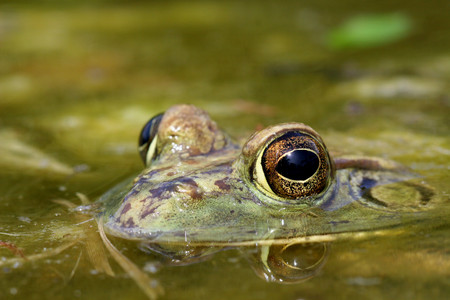
Frog picture from Herpetology Photos
As the ponds freeze and winter comes on, we wondered how frogs
survive, where do they go and what do they do all winter?
Hibernation is a common response to the cold winter of temperate climates.
After an animal finds or makes a living space (hibernaculum) that protects it from winter
weather and predators, the animal's metabolism slows dramatically, so it can "sleep away"
the winter by utilizing its body's energy stores. When spring weather arrives, the animal
"wakes up" and leaves its hibernaculum to get on with the business of feeding and breeding.
Aquatic frogs such as the leopard frog and American bullfrog
typically hibernate underwater. A common misconception is
that they spend the winter the way aquatic turtles do, dug
into the mud at the bottom of a pond or stream. In fact, hibernating
frogs would suffocate if they dug into the mud for an extended
period of time. A hibernating turtle's metabolism slows down
so drastically that it can get by on the mud's meager oxygen
supply. Hibernating aquatic frogs, however, must be near oxygen-rich
water and spend a good portion of the winter just lying on
top of the mud or only partially buried. They may even slowly
swim around from time to time.
Terrestrial frogs normally hibernate on land. American toads
and other frogs that are good diggers burrow deep into the
soil, safely below the frost line. Some frogs, such as the
wood frog and the spring peeper, are not adept at digging
and instead seek out deep cracks and crevices in logs or rocks,
or just dig down as far as they can in the leaf litter. These
hibernacula are not as well protected from frigid weather
and may freeze, along with their inhabitants.
And yet the frogs do not die. Why? Antifreeze!
True enough, ice crystals form in such places as the body
cavity and bladder and under the skin, but a high concentration
of glucose in the frog's vital organs prevents freezing. A
partially frozen frog will stop breathing, and its heart will
stop beating. It will appear quite dead. But when the hibernaculum
warms up above freezing, the frog's frozen portions will thaw,
and its heart and lungs resume activity--there really is such
a thing as the living dead!
Information from Scientific American
September:
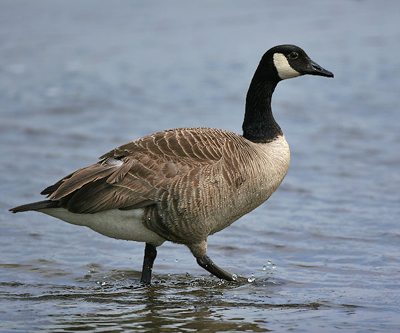
Goose picture from UVM
Keep your eyes on the skies during the next couple of weeks for the high-flying Canada goose migration.
In a learned family tradition, all the geese hatched in certain areas travel to the same winter destination.
Two different populations of migrating geese pass over the Granite State.
One group, called the Atlantic population, travels down the Connecticut River Valley as they wing their
way south from spring breeding grounds in the Hudson and James bays in Canada to their winter home in the Chesapeake Bay.
The Atlantic population, with about 175,000 breeding pairs, is doing very well,
according to Fish and Game Wildlife Biologist Ed Robinson, who predicts a larger fall flight this year than last.
The second population of migrating geese is called the North Atlantic population, with about 197,000 breeding and
non-breeding birds. More of a coastal species, these geese breed during the spring in Labrador in the Maritime
Provinces of Canada, and winter in New Hampshire's Great Bay, as well as in coastal Massachusetts and Connecticut.
This population is also flourishing, and an increased number of birds is expected this year.
New Hampshire has still another group of Canada geese - a resident population of about 30,000 birds.
Though the same species, this population does not migrate. Our resident Canada geese are more productive
than the migrating populations, so can be harvested at different rates by hunters. The resident Canada goose
hunting season, with a higher bag limit than the open season, ended on September 25, before the big surges
of migrants started coming through the state.
Information from NH Fish and Game
August:
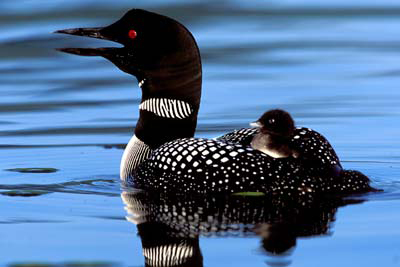
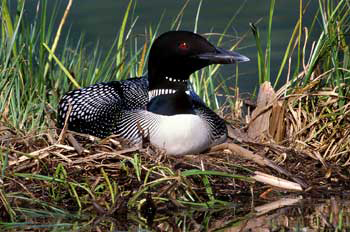
pictures from Loon
Preservation Committee
Loons!
In Washington we are very lucky to have loons nesting on several of our lakes.
They face many challenges for their survival and are on the threatened wildlife list in NH.
Ken told us about two very dramatic reports of a Bald Eagle
attack on a loon chick on Millen Pond. He said the eagle dive-bombed
the chick three times, but luckily it never did get it. The
loon parents were nearby desperately trying to distract the
eagle and he guessed that it helped, as the eagle was not
successful and the chick survived the attack. Island Pond
is also fortunate to have a nesting pair of loons with 2 chicks.
Loons spend their days feeding, preening, resting, and caring for their young.
Their diet in summer consists primarily of fish, and loons eat mostly perch,
suckers, catfish, sunfish, smelt, and minnows. They will also eat crayfish,
frogs, leeches, and snails.
They build their nests close to the water, often on a small
island, muskrat house, half-submerged log, or sedge mat. The
same sites are often used from year to year. Loons will use
mud, grass, moss, pine needles and/or clumps of mud and vegetation
collected from the lake bottom to build a nest. Both the male
and female help with nest building.
Usually one or two eggs are laid in late May or June, and incubation of the eggs
generally lasts 26-28 days. Loon chicks covered in brown-black down appear on
the water in late June or July. Chicks can swim right away, but spend time
riding on their parents' backs to rest, conserve heat, and avoid predators
such as large fish, snapping turtles, gulls and eagles. After their first
day or two of life, the chicks do not return to the nest.
Chicks are fed small food items including minnows, insects and crayfish
caught by their parents for the first few weeks of life, and up until
eight weeks of age, the adults are with them most of the time. Gradually,
the chicks begin to dive for some of their own food, and by 12 weeks of age,
the chicks are providing almost all of their own food and are able to fly.
There are many dangers for loons and their chicks on our lakes.
Swallowing a single lead sinker or jig can kill a loon or
other waterbird. Loon chicks can be killed by an older sibling,
or by an intruding adult loon or other predators. The largest
single source of human-caused chick mortality is from collisions
with fast-moving boats and personal watercraft.
Loon nests fail for a variety of reasons. The close approach
of people can cause incubating loons to flush from the nest,
sometimes resulting in loss of eggs to scavenger birds and
mammals. Please keep your distance if you know loons are nesting
or living on your lake.
Development and recreational pressures on lakes have been implicated in declines
in numbers of breeding loons and in reduced loon breeding success. Several
researchers suggest that shoreline development and associated recreational
use of lakes play an important role in limiting loon populations, and might
be the primary factors in the reduction of the loon's historical breeding range.
The Loon Preservation Committee (LPC) was created in New Hampshire,
in 1975, in response to concerns about a dramatically declining
loon population and the effects of human activities on loons.
LPC’s mission is to restore and maintain a healthy population
of loons throughout New Hampshire; to monitor the health and
productivity of loon populations as sentinels of environmental
quality; and to promote a greater understanding of loons and
the larger natural world. 34 years later they are still at
work around our state.
The Loon Preservation Committee was one of the first organizations anywhere
to show that coordinated and thoughtful human actions could reverse the decline
of a threatened or endangered species.
For more information about loons,
to learn about the LPC's important work with loons, to read
their newsletter or join their organization go here: Loon
Preservation Committee
July:

picture from Lynn Cook
A Tribute to Rich Cook
The Washington Conservation Commission bids a tearful goodbye
to our friend and long time commission member Rich Cook. He
passed away on July 16th following an accident and a valiant
fight to recover from his injuries.
Rich was a true conservationist who loved farming, the natural
world, and all things Washington.
He spent his working years as a Merchant Marine sailing the
world's oceans, serving much of his career as Captain. Though
he visited ports all over the world he always delighted in
returning to his farm in East Washington. Bifrost Farm was
his sanctuary and there he and Lynn and their children raised
and trained Morgan horses, grew organic Shiitaki mushrooms,
kept chickens for eggs and meat and cultivated bountiful vegetable
gardens and berries. He had a deep interest in sustainable
farming and locally raised food.
Rich took great interest in nature and spent a lot of time
in the great outdoors. He cut his own wood and enjoyed hiking
and riding horses. He also loved spending time on the water
sailing and kayaking. Rich had an innate sense of curiosity
about the natural world and the environment and read constantly
to enrich his knowledge.
He joined the Conservation Commission as a member right at
the start and continued on as an ex-officio member after he
was elected to the town's Board of Selectmen. Through the
years, he worked with us on land protection and preservation
projects, watershed restoration and was always willing to
help do whatever needed to be done, including picking up trash
along our highway route and sloshing around in the vernal
pool. He always made it fun and interesting no matter what
we were doing.
He loved the land and his community and gave huge amounts
of his time to both. He had a wonderful and wry sense of humor
and always had great observations and stories to tell. Rich
lived his life doing what he loved and felt passionately about.
His legacy will live on through his children and Lynn and
we will carry on, in his absence, to do the important conservation
work in Washington that we all shared.
We will all miss him terribly but we are all a great deal
richer for having known him. He was truly a "force of nature"
and now, he is a "force in nature". Look for him in the mountains,
in your garden, the beaver bog, or the local pond. He's still
here with us.
June:
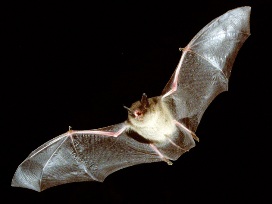
picture from
Duncraft
Have you seen any bats this summer?
In New Hampshire bats are the primary control agents for nocturnal
insect pests a little brown bat can eat over half its body
weight in one night. Because of their high metabolism, bats
also play a role in recycling nutrients through an ecosystem.
New Hampshire is home to eight species of insect-eating bats.
During the summer months, particularly June and July, bats
can be found throughout the state in virtually every habitat.
At night, they can often be seen foraging over waterbodies,
traveling along wooded paths or hunting around street lamps.
During the day, they roost in a large variety of places, including
under tree bark, in rock and tree crevices and in human structures
and barns.
Winter surveys by biologists show that the deadly bat disease
called White Nose Syndrome (WNS) is having
a dramatic impact on New Hampshire's bat populations. Currently,
five of the eight species of New Hampshire bats are affected
by WNS, including the common little brown bat. One species,
the northern long-eared bat, has now disappeared from many
hibernacula (bat wintering places) throughout the Northeast.
WNS first appeared in New York in 2006 and now has been documented
in 11 states; it has expanded as far south as Tennessee and
as far north as Ontario, Canada. Some of the spread can be
attributed to migrating bats, but it is also feared that humans
are transporting the fungus on their caving clothing and gear.
Because of this, the US Fish & Wildlife Service requests all
cavers to disinfect their gear between cave visits. In addition,
do not bring any gear used in an infected state into a cave
in an uninfected state, as disinfection procedures are not
100% effective, and respect all cave closures.
Why is the spread of WNS so important? Bats are the biggest
predator of night-flying insects. Also, recovery from the
onslaught of the disease will be difficult, because bats are
slow breeders. They typically live a long life (over 20 years)
and produce one, or rarely two, pups each year. As with most
young of the year wildlife, not all pups survive, so rebuilding
bat populations after such a rapid decline could take decades.
Hundreds of scientists across the country are working to solve
the mysteries of WNS. We know that the fungus is persistent
it remains in a cave and can infect bats that return there.
Two types of treatments designed to control the fungus on
the bats have been tested, but the results are not yet in.
How can you help? If you have bats in your
barn or house or other buildings, please try to leave them
there, say biologists. Bats breed much more successfully
in large colonies where the combined heat helps the young
bats grow. If you have problems with guano, put a layer of
plastic between the bats and your equipment, but DO NOT seal
the bats in. Also, stay out of caves and mines, year round.
The fungus can be picked up on clothing and gear, and transported
to other sites.
NH Fish and Game would like help this summer counting bats
in your neighborhood, for more information on joining this
worthwhile research project click here: NH
Fish and Game Bat Count
Please help. If you don't have time to count for the state
but you have seen bats, send us an email and let us know where
and when, wcc@washingtonnh.org
Thanks!
This information and more can
be found at: NH
Fish and Game
and NH
Wildlife Journal
May:
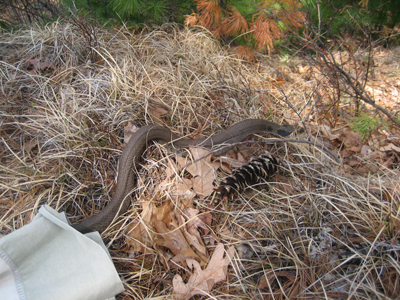
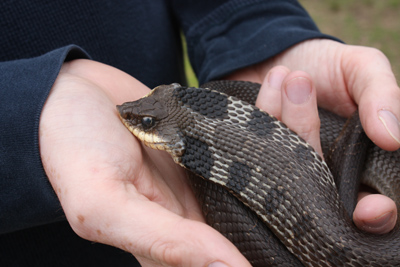
Hognose Snake - pictures from
Arin Mills
Conservation Commission member Arin Mills
works for the NH National Guard as a Conservation Specialist
and she has been tracking an Eastern Hognose Snake
using radio telemetry on one of their properties.
The Eastern Hognose Snake has a thick body, a wide neck, and
a slightly upturned snout and can grow to nearly four feet
long. The color of this snake can vary with yellow, tan, brown
to red and orange with light and dark blotches. There is also
a dark phase in which the body is almost uniform grayish-black
color. It can be confused with the Garter Snake or Timber
Rattlesnake.
They require sandy, gravely soils found in open fields, river
valleys, pine forests, and upland hillsides and live in woods
or fields.
They feed predominately on toads (their favorite meal) and
therefore need breeding habitat (e.g., wetlands, vernal pools)
for amphibians. They will also eat frogs, small mammals, birds,
bird eggs, insects, lizards, smaller snakes, reptile eggs,
and carrion (dead animals).
During June or July the female Hognose lays around 60 eggs
a few inches underground or under woody debris and the eggs
hatch 1 1/2 to 2 months later. In Winter, Hognose snakes hibernate
by burrowing into the soil, or by making a den out of an old
woodchuck, skunk, or fox burrow.
If disturbed by a predator, these snakes have several interesting
ways to defend themselves. First, they will inflate their
necks to look bigger, and they will hiss loudly and strike.
When they do this, they very much resemble cobras. If looking
tough doesn't work, the Eastern Hognose Snake will play dead
and they are very good at it. The snake will roll over and
open its mouth with its tongue hanging out. They will even
stay limp when they are picked up. If you place it right side
up, the snake will flop right back over and play dead. If
this doesn't work, the snake may bite; however, hognose snakes
rarely bite people.
The state ranks this snake as endangered so please let them
know if you see one! Report all sightings of this snake to
NH Fish and Game at 603-271-2461 or
RAARP@wildlife.nh.gov - Photographs are encouraged.
Information from: NH
Fish and Game and Fairfax
County Public Schools Ecology Study
April:

Baby Black Bear at the birdfeeder
- picture from June Manning
Time to take down your bird feeders!
This little guy is cute but his Mom isn't far away and can
do lots of damage to your feeder and property.
"Late March is the time when we typically start seeing
bear activity in New Hampshire. To prevent attracting
a bear to your residence, it is essential that bird feeders
are taken down and put away until next winter," says Andy
Timmins, Bear Project Leader for New Hampshire Fish and Game.
"This isn't about bird feeders, it's about the safety and
wellbeing of black bears. Bears that frequent homes for easy
pickings often have a shorter life expectancy than bears that
don't." Take down your feeders and save a bear.
"Given that sunflower seed is more nutritious than most foods
a bear will find in the woods, it is easy to understand why
some residences get visited by bears every spring," Timmins
added. "Don't be fooled by the fact that several inches of
snow still cover the ground across much of the state; snow
depth has little influence on when bears decide to emerge
from winter dens."
During the denning period, bears typically lose 25% of their
body weight, and a lactating female with newborn cubs may
lose as much as 40%. Post-denning bears are readily attracted
to human related foods. The statewide black bear population
is considered relatively stable -- thanks to careful management
by Fish and Game -- and currently is about 4,800 bears.
Here are a few tips for safety:
Finish your bird feeding activities by April 1 each year.
Don't begin feeding the birds again prior to December 1 or
the onset of prolonged winter weather (the birds will do just
fine). Bears are clever and coupled with their strength and
agility, this makes it very difficult to establish bear-proof
bird feeders. Encourage your bird-feeding friends and neighbors
to adhere to these guidelines. Never intentionally feed bears!
A black bear's presence in a residential area may create fear
among neighbors and lead to negative consequences for the
bear. Regardless of the dates specified above, if a bear
is active in your community, you should cease and desist all
bird feeding activity. Bears that have access to winter
feeders will sometimes remain active, visiting the feeder
late into December, and periodically, beyond.
Information from:NH
Fish and Game
and: NH
Fish and Game Bears
March:
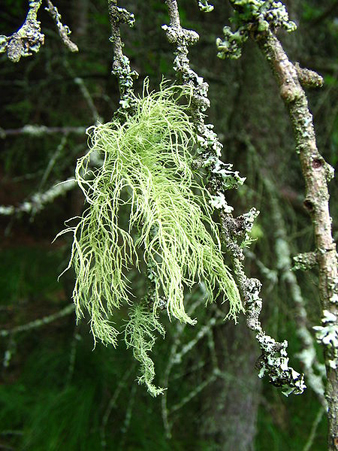
Usnea picture from Wikipedia
While walking near the Bradford Bog, Jed
and Nan found a strange gray/green hairy plant (?) growing
on some tree branches. They wondered what it was and it turned
out to be Usnea.
Usnea is the generic and scientific name for several species
of lichen that generally grow hanging from tree branches,
resembling grey or greenish hair. It is sometimes referred
to commonly as Old Man's Beard, Beard Lichen, or Treemoss.
Usnea looks very similar to Spanish Moss, so much so that
the latter plant's Latin name is derived from it. Usnea grows
all over the world and like other lichens it is a symbiosis
of a fungus and an alga.
Usnea has several unique characteristics which make its identification
easy if stranded in the wilderness far from a hospital. Usnea
lichens can be easily identified by pulling back the outer
sheath on the main stem. Usnea lichens have an elastic pure
white chord running through the center of the main stem. Lichen
species which resemble Usnea do not have this white cord,
and appear grey-green throughout.
Usnea lichen is important to note because it has life-saving
potential. Usnea has been used medicinally for at least 1000
years. Usnic Acid (C18H16O7), a potent antibiotic and antifungal
agent, is found in most species. This, combined with the hairlike
structure of the lichen, means that historically Usnea lent
itself well to treating surface wounds when sterile gauze
and modern antibiotics were unavailable. It is also edible
and high in vitamin C. Native Americans employed it as a compress
on severe battle wounds to prevent infection and gangrene,
and it was also taken internally to fight infections. Usnea
contains potent antibiotics which can halt infection and are
broad spectrum and effective against all gram-positive and
tuberculosis bacterial species.
In modern American herbal medicine, Usnea is primarily used
in lung and upper respiratory tract infections, and urinary
tract infections. There are no human clinical trials to either
support or refute either practice, although in vitro research
does strongly support Usnea's antimicrobial properties.
Information about Usnea
found here : Wikipedia
February:
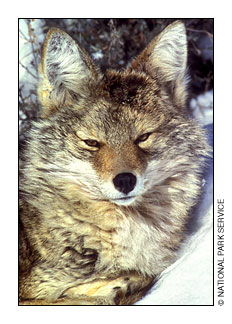
Coyote picture from National
Park Service
Coyotes!
Carol heard coyotes howling recently and they sounded close.
We wondered about the coyotes in this area and here is what
we found out.
New Hampshire's coyotes are eastern coyotes and they typically
weigh 30-50 pounds, are 48-60 inches long, approximately twice
the size of their close relative, the western coyote. Eastern
coyotes have long legs, thick fur, a pointy snout, a drooping
bushy black-tipped tail and range in color from a silvery
gray to a grizzled, brownish red. The average life span of
a wild coyote is four years. Though coyotes are often mistaken
for a domestic dog hybrid, recent genetic research has attributed
the eastern coyote's larger size and unique behavioral characteristics
to interbreeding with Canadian gray wolves. Unlike the wolf
or domestic dog, coyotes run with their tail pointing down.
Although the historical evidence supporting occurrence of
coyotes in New England is inconclusive, no coyotes were present
in the late 1800s. The first verified account of a coyote
in New Hampshire was in Grafton County in 1944. Between 1972
and 1980 coyotes spread across N.H. from Colebrook to Seabrook.
Today, coyotes are common in every county throughout the state.
Coyotes are generalists, eating whatever food is seasonally
abundant. Coyotes are known to feed on mice, squirrels, woodchucks,
snowshoe hare, fawns, house cats, carrion, amphibians, garbage,
insects and fruit. Coyotes utilize forested habitats, shrubby
open fields, marshy areas and river valleys.
The Eastern coyote is a social animal that generally selects
a lifelong mate. Coyotes are quite vocal during their January
to March breeding season. Both parents care for their young,
occasionally with the assistance of older offspring. Four
to eight pups are born in early May.
Within a year some pups will disperse long distances to find
their own territories, while other offspring may remain with
their parents and form a small pack.
Territories range in size from 5-25 square miles and are usually
shared by a mated pair and occasionally their offspring. Coyotes
are capable of many distinct vocalizations - the yipping of
youngsters, barks to indicate a threat, long howls used to
bring pack members together, and group yip-howls issued when
pack members reunite.
Coyotes are elusive, adaptive, intelligent animals that manage
to hold their own when living in close contact with humans.
Most coyote management attempts have been designed to reduce
their population numbers, however, due to their fertility,
behavior and adaptability, those attempts have failed.
The great majority of coyotes don't prey upon livestock. However,
once a coyote learns that young livestock are easy prey, depredation
can become a problem. If this occurs, removal of the offending
coyote is often recommended. However, when farms are situated
in a coyote territory with no depredation, the resident coyote
may actually be an asset to the farm by removing rodents and
preventing problem coyotes from moving into the area. In suburban
areas coyotes have been known to kill house cats. Keeping
your pets and pet food inside at night helps reduce the likelihood
that a family pet will become prey. Coyotes pose little risk
to people and in New Hampshire there has never been a report
of a coyote attacking a person.
Information about coyotes found
here : NH
Fish and Game
January:
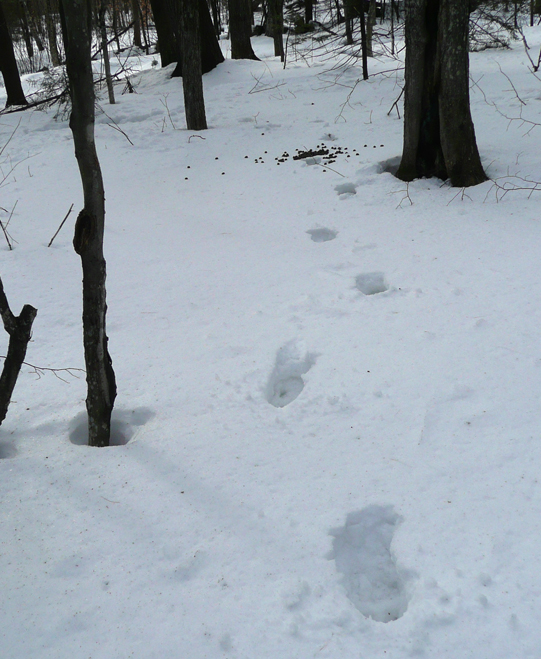
Moose tracks and scat - photos
by Jed Schwartz
Animal tracks in the snow!
Both Sandy and Jed said they have been out enjoying all the
fresh snow cover on XC skis and snow shoes. They each commented
on having lots of fun looking at and trying to identify all
the varied tracks animals leave in the snow. It's a great
time to get out in the snow and have fun tracking animals!
This time of year you can easily see the comings and goings
(and sometimes doings!) of all the animals in our forests
and fields.
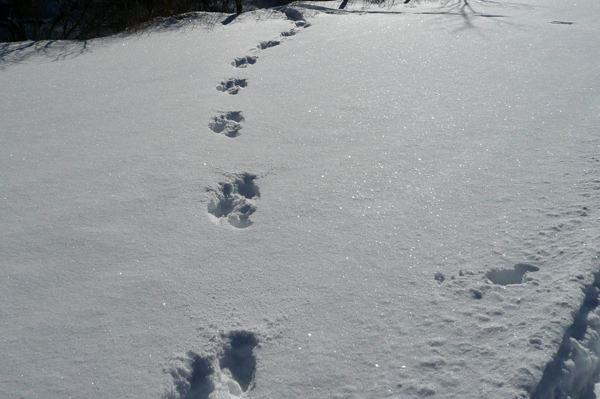 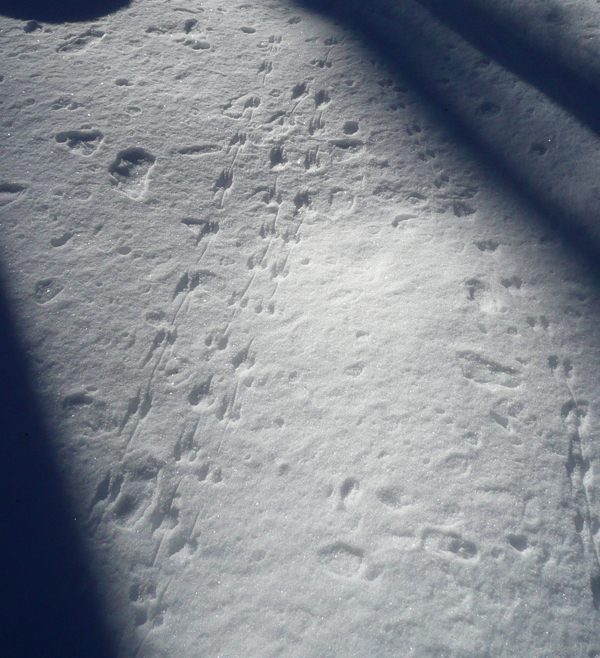
Rabbit tracks
Small mammal tracks
The best time to study animal tracks is in the morning, before
the ground becomes disrupted. Keep in mind the quality of
the tracks will depend on the texture and depth of the snow.
Thus, a crisp early-morning snow will provide for better tracking,
while late-afternoon prints might have turned to slush after
a day of sun. Snow that is too deep will not leave a clear
cut print.
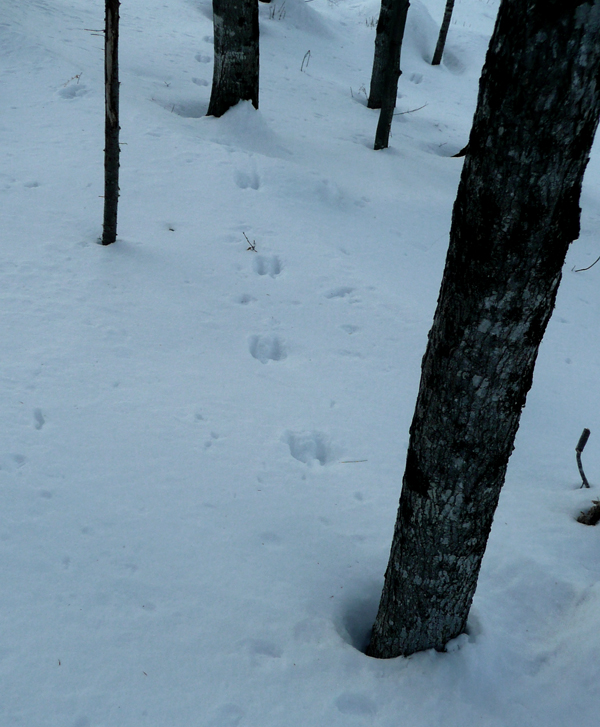
Weasel (?) tracks
Note the location of the tracks as this might help determine
the type of animal that made them. For instance, an otter
will be more likely to make tracks near water. Pay particular
attention to the number of toes, track size, shape and the
presence or absence of claws. Remember that track sizes will
vary according to gender and age. Be on the lookout for gnawed
twigs, tree scrapings and animal droppings, known as scat.
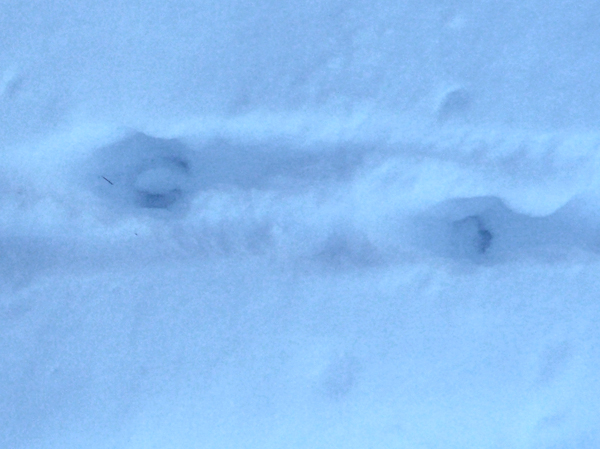 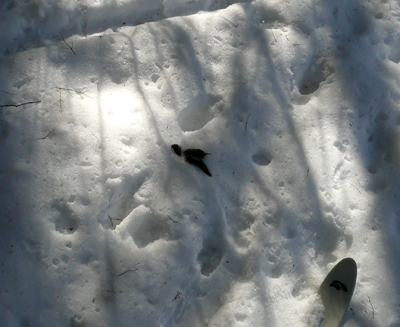
Deer tracks
Coyote
tracks and scat
The best time to study animal tracks is in the morning, before
Animal tracks are classified into many categories based on
individual characteristics.
• Rodents have four front and five back toes with claws.
Animals such as squirrels, rats, chipmunks, porcupines, beavers
and groundhogs are in this category.
• Rabbits have four front and four back toes with the
back feet measuring two times larger than the front.
• The cat family has four front and four back toes,
with claws rarely visible as cats have retractable claws.
Cats' front feet are about a half size larger than the back
feet. House cats, mountain lions, bobcats and the lynx are
members of this group.
• The dog family has four front and four back toes with
claws. The front feet are a third larger than the back feet.
Domestic dogs, foxes, wolves and coyotes are in this category.
• Weasels have five front and five back toes with claws.
Minks, otters, wolverines and badgers are classified in the
weasel family. In most cases, the weasel track will only leave
an impression of four toes.
• Deer have two toes in front and two in the back, with
the front feet about a half size larger than the back feet.
Moose are similar but much larger size with a longer stride.
• Bear, raccoon, opossum and skunk leave human looking-shaped
tracks with five front and five rear toes with claws.
• Wild Turkeys leave a large three toed track. Other large
birds (grouse, crows) are also three toed, crows have a fourth
opposing toe.
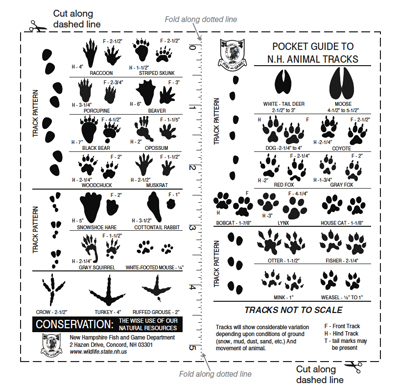
A great tracking card like the one pictured above is available
from NH Fish and Game (see link below) and can help you identify
the tracks you see. Let us know what animal tracks you find
out in your corner of Washington.
Tracking Card is available here
: NH
Fish and Game
Information about identifying
animal tracks was found here: ehow.com
To view yearly archives of our "New In
Nature" series click on year you wish to see.
2002
2003
2004
2005
2006
2007
2008
2009
2010
2011
2012
|


